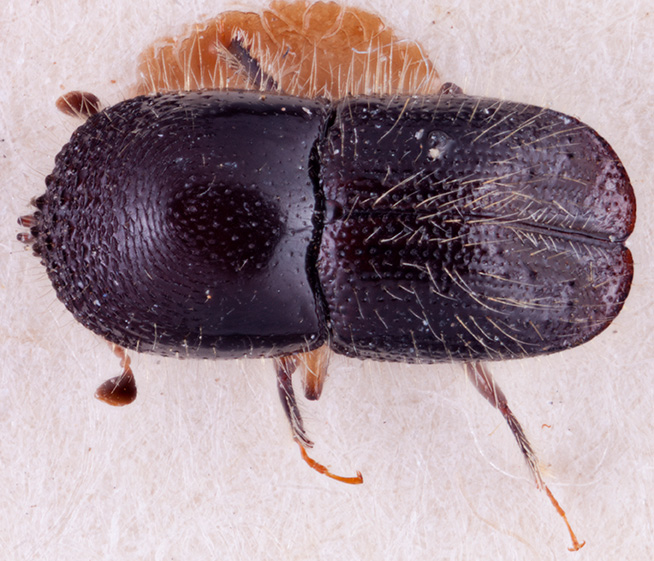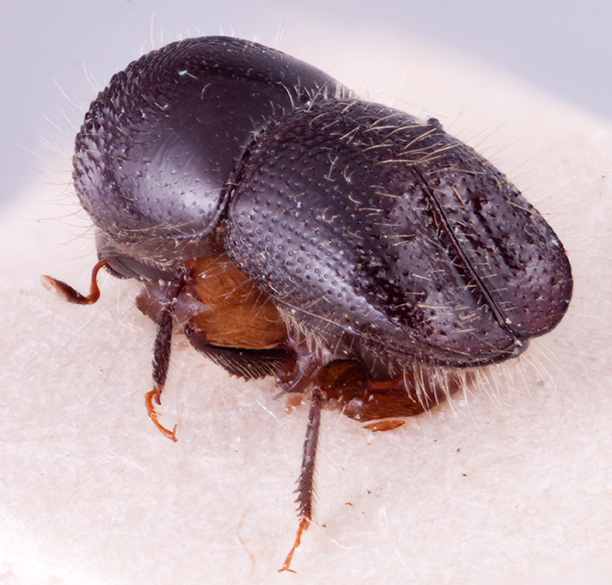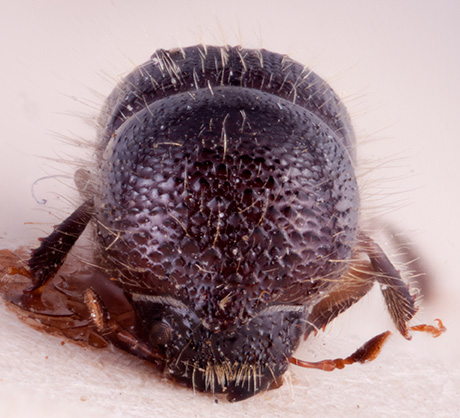Cnestus bicornioides
|
Cnestus bicornoides lateral; R.K. Osborn |
|
Cnestus bicornoides dorsal; R.K. Osborn |
|
Cnestus bicornoides declivity; R.K. Osborn |
|
Cnestus bicornoides frontal; R.K. Osborn |
Taxonomic history
Xyleborus bicornioides Schedl, 1952a: 368.
Cnestus bicornioides (Schedl): Browne, 1955: 360.
Diagnosis
3.3−3.7 mm long (mean = 3.42 mm; n = 5); 2.36−2.75 times as long as wide. This species can be distinguished by the absence of a mesonotal mycangial tuftmycangial tuft:
tuft of setae that denotes the mycangia exterior opening
 on the pronotalpronotal:
on the pronotalpronotal:
pertaining to the pronotum
basebase:
point or edge closest to the body; opposite of apex ; elongate body; elytralelytral:
; elongate body; elytralelytral:
pertaining to the elytra
declivitydeclivity:
downward slope of either the pronotum or elytra
 excavated; pronotumpronotum:
excavated; pronotumpronotum:
the dorsal surface of the thorax
from dorsaldorsal:
of or relating to the upper surface; opposite of ventral
 view type 6; pronotumpronotum:
view type 6; pronotumpronotum:
the dorsal surface of the thorax
apexapex:
point or edge furthest from the body; opposite of base
 strongly producedproduced:
strongly producedproduced:
referring to a part of the exoskeleton that is extended, lengthened or elevated
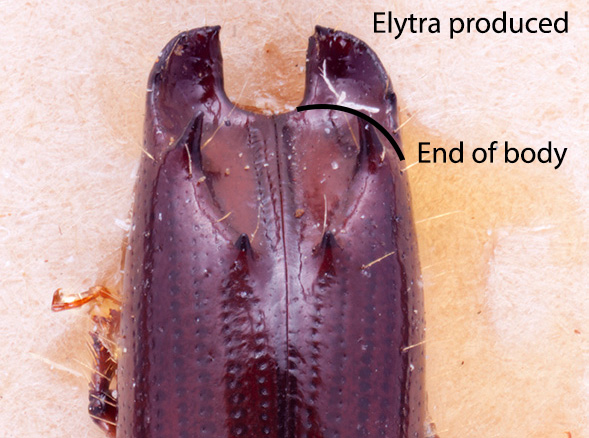 , extending to a process with two serrations; mandibles normal; epistomaepistoma:
, extending to a process with two serrations; mandibles normal; epistomaepistoma:
the sclerotized region of the head above the mandibles and below the frons
entireentire:
without marginal teeth or notches
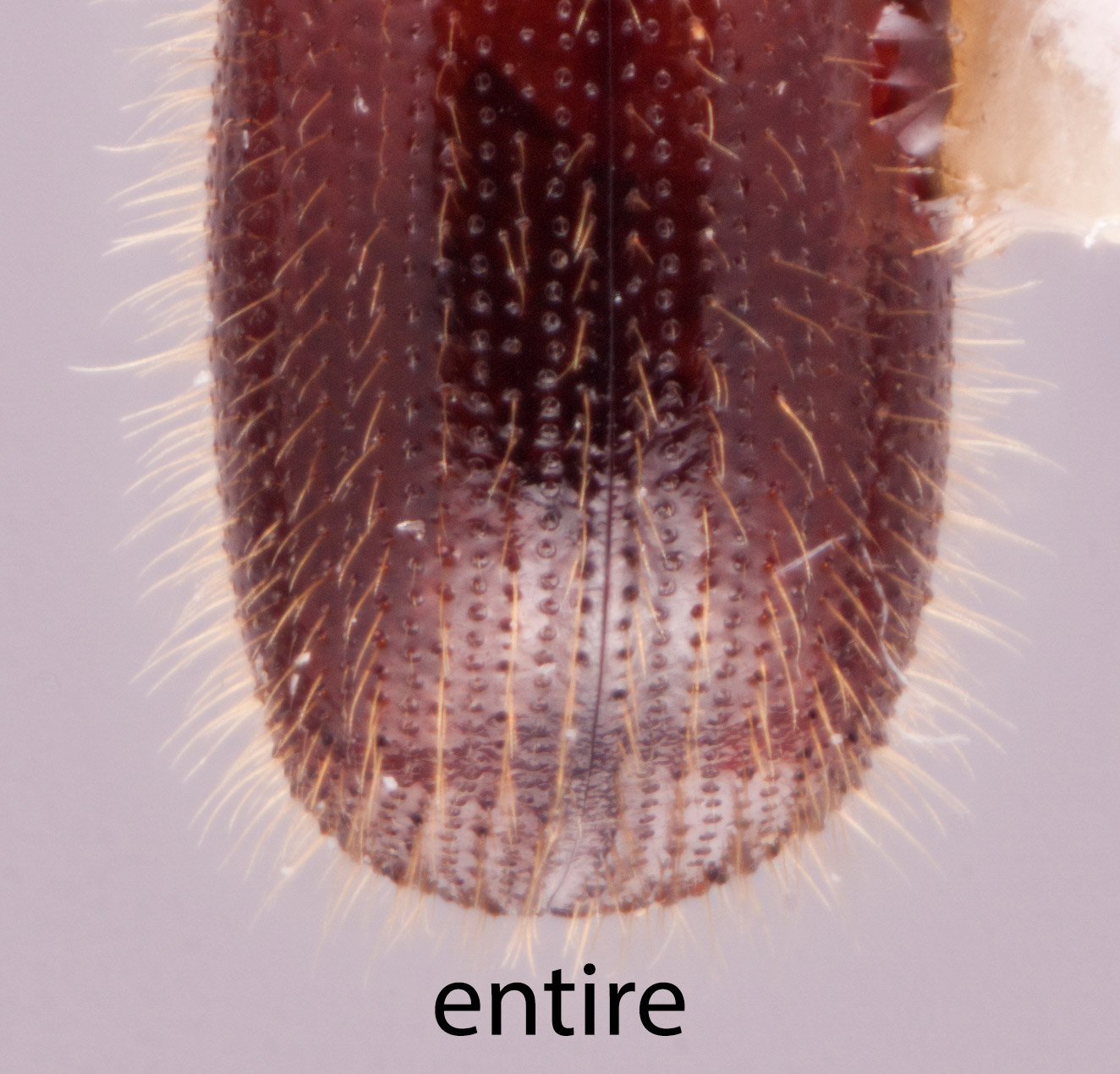 ; elytralelytral:
; elytralelytral:
pertaining to the elytra
punctures distinct, clearly uniseriate; interstriaeinterstria:
longitudinal spaces along the elytra between the striae, which is not as<br />
impressed and bear smaller punctures.
 bearing sparse erecterect:
bearing sparse erecterect:
pertaining to setae that have their apices directed away from the body and appear straight
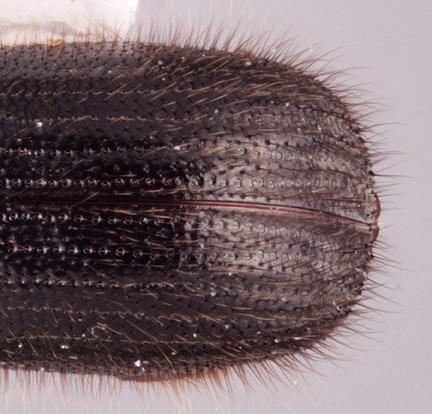 hair-like setae; declivitaldeclivital:
hair-like setae; declivitaldeclivital:
pertaining to the elytral declivity
interstriae 2−5 sparsely denticulatedenticulate:
covered in denticles
; protibiaprotibia:
tibia of the first pair of legs
very slender with three large, narrow denticles; antennalantennal:
pertaining to the antennae
club type 2, with two sutures visible on the posteriorposterior:
toward the rear end; opposite of anterior
 face; and three segmented antennalantennal:
face; and three segmented antennalantennal:
pertaining to the antennae
funicle.
May be confused with
Cnestus bicornis (Eggers) (from Indomalayan region) and C. quadrispinosus
Distribution
China (Xizang, Yunnan), India (Andaman Is, West Bengal), West Malaysia, Philippines, Thailand
Host plants
recorded from Shorea (Dipterocarpaceae) Swietenia (Meliaceae) (Browne 1961bBrowne 1961b:
Browne FG. 1961b. The biology of Malayan Scolytidae and Platypodidae. Malayan Forest Records 22: 1-255.) and Fagaceae ((Smith et al. 2020bSmith et al. 2020b:
Smith SM, Beaver RA, and Cognato AI. 2020b. A monograph of the Xyleborini (Coleoptera, Curculionidae, Scolytinae) of the Indochinese Peninsula (except Malaysia) and China. ZooKeys 983: 1-442. https://doi.org/10.3897/zookeys.983.52630)
Remarks
The entries in Maiti and Saha (2004) under the name Cnestus cruralis (Schedl) refer to this species, which was earlier (Maiti and Saha 1986Maiti and Saha 1986:
Maiti PK, Saha N. 1986. Contributions to the knowledge of the bark and timber beetles (Scolytidae: Coleoptera) of the Andaman and Nicobar Islands. Records of the Zoological Survey of India, Miscellaneous Publications, Occasional Papers 86: 1-182.; Saha and Maiti 1996Saha and Maiti 1996:
Saha N, Maiti PK. 1996. Insecta: Coleoptera: Scolytidae. Fauna of West Bengal, 6B: 775-866.) referred to as C. bicornioides. The species described as Xyleborus cruralis Schedl belongs in the genus Microperus Wood (Beaver 1998Beaver 1998:
Beaver RA. 1998. New synonymy, new combinations, and taxonomic notes on Scolytidae and Platypodidae (Insecta: Coleoptera). Annalen des Naturhistorischen Museums in Wien, Series B, Botanik und Zoologie 100B: 179-192.).
DNA data
specimens not available for sequencing


